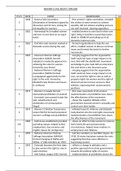WOMEN’S CIVIL RIGHTS TIMELINE
P/L/S DATE EVENT SIGNIFICANCE G/B
1848 - Seneca Falls Convention - first women’s rights convention, revealed
S (Declaration of Sentiment signed by the wishes of some women to achieve
68 women and 32 men, aiming for equality, did not achieve anything and was
full equality for women) not well-received, showing opposition
1862 - Homestead Act (enabled women - enabled women to own land in their own
S and men to own land on an equal right, living in isolation caused depression,
basis) death in childbirth and taking up of all
domestic/maternal roles
1865 - Civil War ends (women worked in - formed organizations to help the war
S domestic service during the war) effort, enabled women to discuss common
issues and formed the basis for further
movements
1869 - American Woman Suffrage - merging suggests that the organisation
Association (AWSA) formed itself could not have a large impact on its
P (adopted a moderate approach to own, link with the abolitionist movement
achieving the vote for women, and pledge to give male African Americans
formed by Lucy Stone) the vote led to a less focussed cause
- National Women’s Suffrage - merging suggests that the organisation
Association (NWSA) formed itself could not have a large impact on its
(campaigned aggressively for the own, secured the right to vote as well as
P right to the vote, formed by property rights for women and the right of
Elizabeth Cady Stanton and Susan divorced women to have access to their
B. Anthony) children, improving their socioeconomic
positions
1873 - Women’s Crusade formed - first mass movement of US women,
S (demanded prohibition of alcohol) implementation of prohibition laws shows
- Comstock Laws passed (made the the effectiveness of the movement
sale, advertisement and - shows the negative attitude of the
S distribution of contraceptives government towards women’s sexuality and
illegal) control over their bodies
1874 - Women’s Christian Temperance - initiated Susan B. Anthony and Elizabeth
S Union (WCTU) formed (promoted Cady Stanton into the civil rights movement,
women’s suffrage and prohibition) implementation of prohibition laws shows
the effectiveness of the movement
1889 - Hull House established (provided - shows an effort to help women to improve
S/E parenting classes, helped to find their family life and socioeconomic
employment, day nurseries and circumstances, helped many mothers in
English classes for immigrants) employment and childcare
1890 - National American Woman - had few members so had little impact, by
P Suffrage Association (NAWSA) 1918, 20 states had given women the vote,
formed (merging of AWSA and suggesting that they were effective in
NWSA, 17,000 members by 1905) franchising women
1893 - Colorado becomes the first state - reflects a change in attitudes and a
P to give women the right to vote in positive approach from state governments
state elections towards the political rights of women
- Anti-Saloon League (ASL) formed - implementation of prohibition shows the






